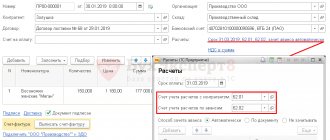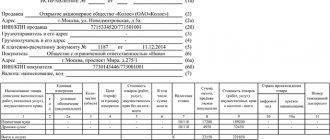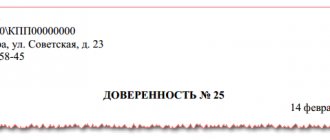Scope of the invoice
Invoices (hereinafter also referred to as s/f, sch-f) are issued by companies and individual entrepreneurs – VAT payers – in the following cases:
In certain cases, VAT non-payers also issue accounts and pay VAT to the budget. For example, a special regime officer is required by law to perform the functions of a tax agent.
An invoice is a document used to claim a VAT deduction. Without an invoice from your counterparty (supplier or contractor), you will not be able to reduce the VAT calculated for payment.
Since the account is used in the area related to the calculation of taxes, the use of this document is regulated by the Tax Code of the Russian Federation (Article 169)
An invoice filled out in violation of the requirements cannot be accepted for accounting and used to obtain a VAT deduction (clause 2 of Article 169 of the Tax Code of the Russian Federation).
Information contained in invoices and information indicated in the adjustment invoice
The formation of any invoice also includes such a stage as indicating all the necessary information there. It should include:
- the exact name , form and quantity of services, goods, or types of work of the supplier that are included in the sale to another individual - the buyer ;
- the estimated period within which the registration , printing and signing of the invoice is carried out, as well as the period within which all the conditions specified there must be met;
- settlement account of the supplier , or his agent , as well as another authorized person who has the right to sign invoices ;
- all necessary and mandatory invoice details, the absence of which is a serious violation that can be identified by any organized inspection .
According to the provisions of the current tax legislation, the adjustment invoice must also indicate certain data. These include:
- exact name of services, goods, or work , their quantity , processing , general order of execution, deadline VAT amount , etc.;
- the specific name of the service, work , or product for the sale of which there was an increase or decrease in price;
- summary calculation , verification , processing and reconciliation VAT amount ;
- stamp of an authorized person.
When another person has received an adjustment invoice , the reconciliation , verification and processing of which have been carried out, all conditions for changing the price are considered fulfilled.
Required invoice attributes
Let's consider the elements of the s/f, without which the document will not be considered valid (clause 5 of Article 169 of the Tax Code of the Russian Federation):
If the s/f contains or lacks any details not mentioned in clause 5 of Art. 169 of the Tax Code, this cannot be an obstacle to tax deduction.
clearly on the invoice :
If there is an error in the invoice that does not prevent an unambiguous interpretation of the meanings of its details listed in the diagram above, then a deduction for such an invoice can . However, in some cases, claims from tax authorities may still arise, so it is better not to make .
Here are examples of minor invoice errors:
It is not enough to indicate all the required attributes of the account. It is important to enter them correctly . Rules for filling out invoices can be gleaned from two sources:
Sales invoice details
This invoice is used most often; it is characterized by a full set of details:
- The number and date of the document (when filling out a correction, the correction number line must also be filled in).
- Details of the seller and buyer: name, address, TIN. How to correctly indicate the address on the invoice, see here.
- Names and addresses of the shipper and consignee.
- Details of the payment document, if an advance payment was received for delivery.
- The currency in which the document is drawn up.
- Identifier of the government contract, agreement (agreement) (if any).
- Name of goods (works, services) indicating the code of the type of goods, unit of measurement, quantity and cost of the unit.
- The total cost of the goods without taxes, the amount of excise duty, the rate and amount of VAT, the total cost with taxes.
- Country of origin of the goods and registration number of the customs declaration.
- Signatures of responsible persons.
In some cases, the document may be missing:
- Checkpoints between the seller and the buyer, provided for in the forms approved by Decree of the Government of the Russian Federation of December 26, 2011 No. 1137.
- Details of the consignor and consignee, if it is not the product being sold.
- Details of the payment document if there was no advance payment.
- Unit of measurement, quantity and price of the unit, if the unit of measurement is not defined (clauses 5 and 6 of Article 169 of the Tax Code of the Russian Federation).
- Code of the type of goods, if the goods are exported to member countries of the EAEU.
- The amounts of taxes related to the product and the VAT rate, if the product is not excisable and the taxpayer operates without VAT.
- Data on the foreign origin of the product if it was produced in the Russian Federation.
- Identifier of the government contract, agreement (agreement)
If there are no details in the designated place on the forms approved by Decree of the Government of the Russian Federation dated December 26, 2011 No. 1137, dashes are added. The exception is data on taxes: for them, in the corresponding column of the document, the entries “Without excise duty” and “Without VAT” are made. In this case, the last entry is entered both in the rate column and in the tax amount column.
See also “The seller did not put a dash in the 8th line of the invoice - ask for a correction?”
Other invoice details are mandatory. Errors made when indicating them, if they do not interfere with the correct understanding of the essence of these details, do not affect the possibility of receiving deductions (clause 2 of Article 169 of the Tax Code of the Russian Federation).
Find out what errors in the invoice prevent deductions from the Typical Situation from ConsultantPlus. Learn the material by getting trial access to the system for free.
Are errors in the name of a product critical for deducting VAT? Read the material “Works or services are indicated in the invoice in general and with errors: will it be possible to defend the deduction?” .
Invoice form
The invoice form was approved by Decree of the Government of the Russian Federation dated December 26, 2011 No. 1137. It can be downloaded for free from our website using the link below:
This Resolution introduced the form of not only a regular invoice, but also another type of this document - an adjustment invoice.
Later in the article we will talk about sample invoices. Here you will receive information on how to fill out an invoice, some problematic fields and special cases.
Procedure for drawing up and conditions for drawing up an invoice
The rules of existing tax law establish a certain procedure for issuing an invoice, as well as additional conditions and requirements under which the formation , registration , maintenance , export and provision of a document to another person will be possible, and it will be possible for him to accept it.
The current requirements and general procedure provide for such an important aspect as a deadline that must be observed when generating, maintaining , exporting , issuing an invoice and providing it to another person who must accept it.
The generation and issuance of an invoice, its reconciliation and processing must be carried out within 5 calendar days from the date of direct shipment of the seller’s goods to the buyer or his agent representative, provision of services, or performance of certain work.
At the same time, in addition to issuing an invoice, the taxpayer must also maintain all necessary reporting and comply with the rules for filling out the invoice, in the event that the objects under the contract , the name of which is indicated, are subject to VAT .
The immediate conditions for issuing and drawing up invoices depend, first of all, on the types of objects themselves under the contract of the supplier or agent , or the seller to the buyer , who must accept the goods.
The name of these goods , work , or services involved in the sale to the buyer must necessarily be a legal object of taxation and VAT .
How to fill out various invoices
The main invoice form is used in different VAT accounting situations. The filling procedure in these cases is also different:
Shipment of goods/works/services: what an invoice looks like
There should be no difficulties in entering data into the invoice. Let's note some non-obvious things in the diagram:
Received an advance: what are the features of the invoice?
Let's look at how to make an invoice for an advance payment. Let's change the situation: let's say that for the same shipment for which we showed the invoice above, we paid in advance.
Let's put on the diagram the positions for filling out the advance account, about which questions and doubts :
General rules for preparing invoices
An invoice is classified as an important document for several reasons. When we need to charge the amount of VAT to the budget, we act according to a certain scheme. First, VAT must be calculated, then the VAT amount must be deducted, and then, if certain circumstances arise, the VAT amount must be restored. And at all these stages, the first document appears is the invoice. Each indicator in our formula depends on how we compile it, because ultimately it is reflected in the tax return.
First, the invoice (if we are talking about accrued VAT) is registered in the sales book and then transferred to section 9 of the declaration. One mistake on the invoice and you are charging VAT incorrectly. Next, you need to subtract the amount of VAT that is accepted for deduction, again on the invoice. Next, the invoice is usually registered in the purchase book, and then the data is transferred to section 8 of the declaration. This means that if you make any mistake on your invoice, you are applying the deduction incorrectly. If you increase the deductible amount, penalties may apply.
The third indicator is that the amount of VAT to the budget increases by the amount of the restored VAT. A common situation: we recover primarily based on the invoice, which we register in the sales book, and then reflect this indicator in section 9 of the declaration.
Find out how to minimize the risk of additional VAT charges
To learn more
Shipping conditions have changed: what invoice to make?
It is necessary to distinguish when to write out a corrective account and when to write a corrected one. Adjustment and correction are different facts of economic activity. Therefore, they require reflection in different documents.
A corrected invoice is used if an error - technical or arithmetic. The algorithm for selecting a form for a corrected account is simple:
But when we take the form of the adjustment account (clause 1 of Article 169 of the Tax Code of the Russian Federation):
Check out the option for filling out the account when adjusting a shipment:
And here is a diagram with the nuances of entering data into the account, which is written out when revising the terms of shipment:
Numbering of invoices
- The number is indicated in line 1.
- The number is assigned in ascending chronological order.
- The period for renewing the numbering of invoices is at the discretion of the organization (month, quarter, year).
- The number must be supplemented through “/” with digital indices in the case of drawing up an invoice by a separate division, a participant in a simple partnership or a trustee for goods (work, services) sold under the relevant agreement.
Difficult aspects of filling out an invoice, correcting unacceptable errors, practical examples
Find out more
How have the requirements for filling out an invoice changed since October 1, 2017?
- Added a new column – “Product type code”
From October 1, 2017, column 1a “Product type code” appeared. This column must be filled out by companies exporting their goods to the countries of the Eurasian Economic Union. If there is no data on the product type code, a dash is added.
- It is possible to sign an authorized person
Now, from October 2021, invoices can be signed not only by holders of the right to sign for managers and chief accountants, but also by authorized persons.
- Changed column 11 – “Registration number of the customs declaration”
Column 11 is now called “Customs Declaration Registration Number”. In the field for the customs declaration number, you must indicate the registration number.
- Line 8 is brought into line with the rules for filling out invoices
For the “government contract identifier” line that appeared on the invoice form in July 2021, a clarification was added that this item must be completed if available.



